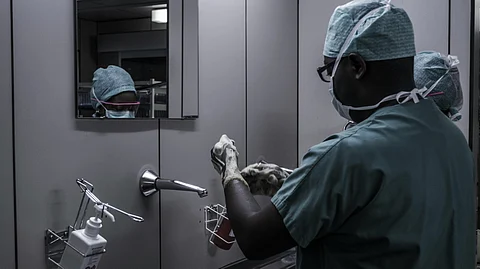

The National Consumer Disputes Redressal Commission (NCDRC) has revised the definition of negligence in the healthcare system. According to the new ruling, mere lack of care, an error in judgment, or an accident does not constitute negligence in the medical profession. This decision was made by the apex consumer court, presided over by Justice Ram Surat Maurya and Mr. Bharat Kumar Pandya. The NCDRC clarified that negligence in the medical field is considered if an injury results from an act or omission.
The court further emphasized that to claim negligence, there must be a breach of duty resulting in damages, and negligence can only be claimed if it is related to the treatment provided.
This observation by the NCDRC came during the hearing of a medical negligence complaint against Shri Balaji Action Medical Institute. In 2008, a complaint was registered by a patient who alleged that he was suffering from a high-grade fever and was diagnosed with dengue by the hospital's doctors. He was immediately admitted to the ICU, where all necessary tests were conducted.
The test for dengue returned negative for the Dengue NS-1 Antigen. During his treatment in the ICU, the patient's platelet count dropped, and he started losing vision in both eyes. Despite informing the doctors and nurses about his deteriorating eyesight, his condition worsened, and the next morning, a senior doctor advised an MRI. The MRI report revealed subcutaneous edema in the bilateral eyelids and pathological changes in the walls of the optic globes.
The doctors were unable to control the infection, and the patient lost his eyesight completely. He was then referred to AIIMS Delhi, where doctors informed his father that they could not diagnose the reason for the loss of vision. Subsequently, he was admitted to the Dr. Rajendra Prasad Centre for Ophthalmic Sciences at AIIMS, where he was hospitalized for weeks without any improvement in his condition. Despite consulting other doctors, he was unable to regain his eyesight.
The patient alleged that due to the negligence of the treating doctors, he became permanently blind. He also claimed that if the hospital was not equipped to handle such cases, they should not have admitted him. He sought compensation of ₹50 lakhs for the loss of eyesight, ₹25 lakhs for physical pain and mental agony, and ₹5 lakhs for medical expenses, with interest at 18% per annum from the date of loss of vision until payment.
The hospital countered that the patient was admitted with acute febrile illness, severe thrombocytopenia, bleeding diathesis, and bleeding gums. He also had purpuric spots on his legs and was immediately examined by a senior consultant and unit head of the hospital. The hospital suspected gastrointestinal bleeding, and blood tests revealed a platelet count of zero.
Given the patient's symptoms and the reports of a dengue fever outbreak, four units of platelet concentrate and one unit of platelet apheresis were transfused. There was also bleeding from multiple sites, so two units of fresh frozen plasma (FFP) were administered along with IV fluids. Further analysis and reports indicated that the patient had life-threatening thrombocytopenia and hemoconcentration. Mildly deranged prothrombin time and positive dengue reports suggested secondary or tertiary dengue infection. He also had right pleural effusion, ascites, and an edematous gall bladder. His diagnosis was Dengue Hemorrhagic Fever. The hospital stated that he was examined by a qualified resident doctor and was constantly monitored.
Regarding his blurred vision, he was referred to a senior consultant ophthalmologist, who diagnosed intraorbital/cerebral haemorrhage and advised a CT scan. The CT scan revealed focal hypo densities in the left parietal region near the convexity and no evidence of intracranial haemorrhage.
A neurologist was also consulted and suspected acute optic neuritis, vitreous hemorrhage due to haze, and the patient was then advised to undergo an MRI. The MRI revealed microbleeds in the bilateral frontoparietal subcortical and periventricular white matter and basal ganglia. There was also subcutaneous edema in the bilateral eyelids with pathological thickening of the walls of the optic globes. The ophthalmologist reviewed the patient and observed epithelial edema and edema defects over the cornea in both eyes. Due to the lack of improvement, he was referred to AIIMS for further treatment.
The hospital claimed that the patient was treated with the proper standard protocol, compassion, humane touch, and best care, and no medical negligence was committed.
The state commission involved an expert from Maulana Azad Medical College, New Delhi, and formed a medical board to examine and review all the papers. The board submitted its report stating that no medical negligence was committed by the hospital during the treatment. The patient also took his complaint to the Delhi Medical Council, which conducted an inquiry and reached the same conclusion.
However, the state commission observed that the patient had complained about blurring vision, and after the ophthalmologist attended to him and advised a CT scan and MRI, there was a delay in obtaining the reports. This delay was deemed crucial for the patient, and the state commission held the hospital negligent for not adequately addressing the patient's vision, resulting in permanent damage. Consequently, the hospital was ordered to pay ₹35 lakhs as compensation for the loss of eyesight and medical expenses to the patient.
The hospital challenged the state commission's decision and approached the NCDRC. The NCDRC found that the delay in diagnosing and managing the eye condition was not attributable to the hospital or its staff. Instead, the patient's eye injury was due to complications arising from Dengue Hemorrhagic Fever. The commission also noted that even after the MRI, no abnormality could be detected in the optic nerves or the brain, leading to the conclusion that the eye injury was related to the systemic effects of dengue fever rather than any delay or oversight by the treating ophthalmologist. Thus, the NCDRC granted relief to the hospital and dismissed the negligence claim.
Input from various sources
(Rehash/Yash Kamble/MSM)
